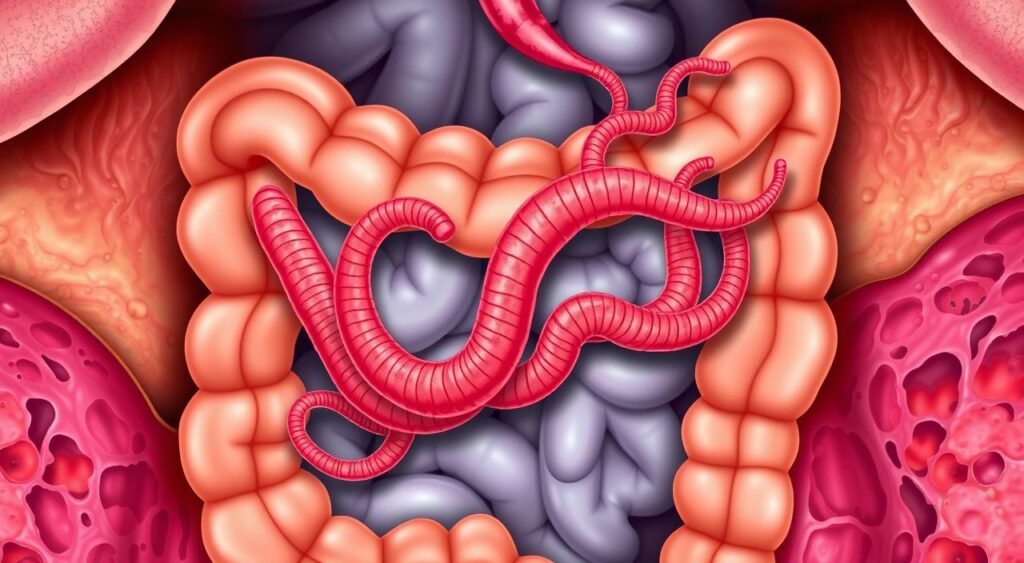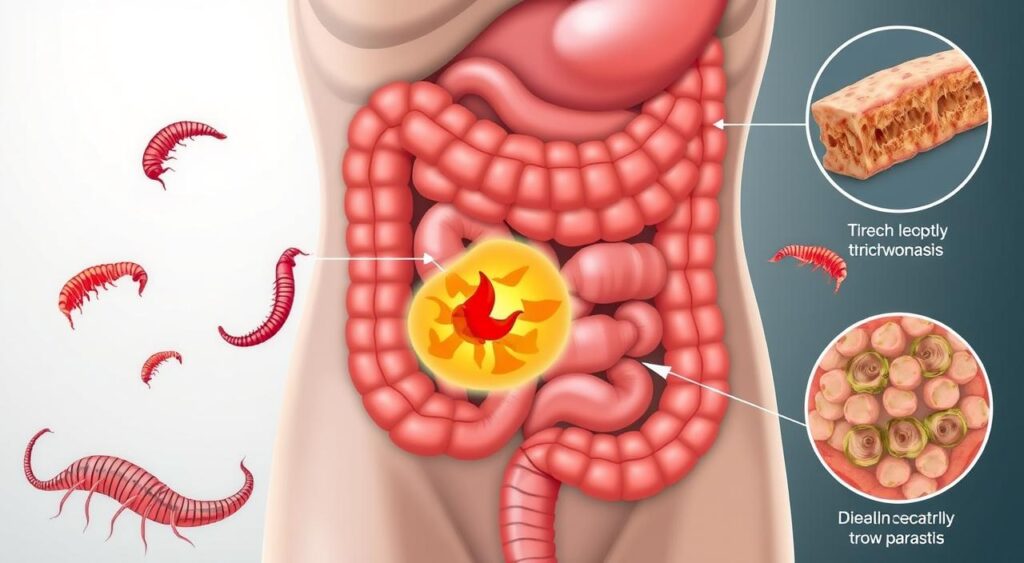Over 464 million people worldwide suffer from trichuriasis, a parasitic infection. It’s caused by the whipworm parasite, trichuris trichiura. This infection is a big public health issue, especially in places where cleanliness is hard to maintain. It can cause serious health problems, so it’s important to know about its causes, symptoms, and treatments.

Trichuriasis, or whipworm infection, affects millions worldwide. The trichuris trichiura parasite is the main culprit. It spreads through contaminated food, water, or soil. Knowing the risks and how to prevent and treat it is key.
Key Takeaways
- Trichuriasis is a parasitic infection caused by the whipworm parasite, trichuris trichiura.
- The disease affects approximately 464 million people worldwide.
- Trichuriasis is a significant public health concern in developing countries.
- The infection can lead to severe health complications if left untreated.
- Understanding the causes, symptoms, and treatment options is essential for managing trichuriasis.
- Prevention and early diagnosis are critical for reducing the risk of trichuriasis.
Understanding Trichuriasis and Its Cause
Trichuriasis is a parasitic infection caused by the trichuris trichiura worm. It’s a big health problem around the world. Knowing how it starts is key to stopping it and treating it well. The trichuris infection can cause symptoms that range from mild to very serious.
The trichuris trichiura worm goes through several stages: egg, larva, and adult. People get infected when they eat food or drink water with the worm’s eggs. The eggs then hatch in the gut, and the larvae grow into adult worms. These adult worms live in the gut, eating blood and nutrients.
Places with bad sanitation and hygiene have more trichuris infection. People with weak immune systems also face more severe symptoms. Knowing how the worm lives and how it infects people helps in finding ways to prevent and treat it.
| Stage | Description |
|---|---|
| Egg | The eggs of the parasite are ingested through contaminated food or water |
| Larva | The eggs hatch in the intestine, and the larvae develop into adult worms |
| Adult Worm | The adult worms attach to the intestinal wall and feed on blood and nutrients |
By knowing the cause of trichuriasis and the life cycle of the trichuris trichiura worm, we can prevent infection. This is important for stopping the spread of the infection and improving health for everyone.
Common Symptoms of Trichuriasis
Trichuriasis is caused by the parasitic worm Trichuris trichiura. It can cause many symptoms. These include abdominal pain, diarrhea, weight loss, and feeling very tired.
In severe cases, it can lead to rectal prolapse. This is when the rectum bulges out because it’s not attached right.
The symptoms of trichuriasis depend on how many worms are in the intestines and the person’s health. In places where trichuriasis prevalence is high, it affects many, especially kids and those with weak immune systems.
- Abdominal pain and tenderness
- Diarrhea or bloody stools
- Weight loss and decreased appetite
- Fatigue and weakness
If you have these symptoms, see a doctor. This is especially true if you’ve been to areas where trichuriasis is common or if you’ve eaten or drunk something contaminated.
Knowing the symptoms of trichuriasis and how common it is helps in preventing and treating it. By recognizing the signs and preventing its spread, we can lessen its effects on people and communities. This helps in reducing trichuriasis prevalence worldwide.
| Symptom | Description |
|---|---|
| Abdominal pain | Persistent pain or tenderness in the abdominal area |
| Diarrhea | Frequent, loose, or bloody stools |
| Weight loss | Unintentional weight loss due to decreased appetite or malabsorption |
Risk Factors and Global Prevalence
Trichuriasis is a big problem in many places, especially where sanitation and hygiene are poor. The whipworm parasite, or trichuris infection, affects millions globally. It’s most common in tropical and subtropical areas.
Several factors increase the risk of getting trichuriasis. These include:
- Children and adults in areas with bad sanitation and hygiene
- People with weak immune systems, like those with HIV/AIDS or on chemotherapy
- Those who work with soil or feces, like farmers or sewage workers
Where you live also affects your risk of trichuriasis. Environmental factors like climate and soil type help spread the parasite.
Knowing about trichuriasis risk and global spread is key to fighting it. By focusing on high-risk groups and areas, health workers can help stop the spread. This improves health for everyone.
Diagnosis Methods and Testing
Diagnosing trichuriasis often requires a physical exam, medical history, and lab tests. A key method is examining stool samples. This can reveal trichuris trichiura eggs or worms.
Blood tests might also be used. They look for antibodies or markers of infection. Since symptoms can be similar to other infections, diagnosing trichuriasis can be tricky.
Here are some common ways to diagnose trichuriasis:
- Stool examination: This involves examining a stool sample under a microscope to look for trichuris trichiura eggs or worms.
- Blood tests: These tests can help detect the presence of antibodies or other markers that indicate an infection.
- Endoscopy: This involves using a flexible tube with a camera to examine the inside of the intestines and look for signs of infection.
Getting a correct diagnosis is key for treating trichuriasis. Without treatment, it can cause malnutrition and intestinal blockage.
| Diagnosis Method | Description |
|---|---|
| Stool examination | Examination of stool sample under a microscope to look for trichuris trichiura eggs or worms. |
| Blood tests | Detection of antibodies or other markers that indicate an infection. |
| Endoscopy | Examination of the inside of the intestines using a flexible tube with a camera. |
Treatment Options for Trichuriasis
Trichuriasis is a parasitic infection that needs quick medical care to avoid serious problems. The main goal of treatment for trichuriasis is to get rid of the parasites and ease symptoms. There are many trichuriasis treatment options, like medicines and supportive care.
Medicines are the key to treating trichuriasis. Albendazole and mebendazole are the most used drugs. They target the parasites. Treatment usually lasts from 3 to 7 days, based on how bad the infection is and how well the patient responds.
Medication Options
- Albendazole: This medication works well against many parasites, including Trichuris trichiura.
- Mebendazole: It’s also good against Trichuris trichiura and is often paired with albendazole.
It’s important to keep an eye on the patient after treatment. Look out for signs of the infection coming back or serious problems like intestinal blockage or rectal prolapse. With the right treatment for trichuriasis and aftercare, most people can fully recover.
Follow-up Care
Regular visits to the doctor are key to track the patient’s progress and tweak the treatment if needed. Patients should also learn about trichuriasis treatment options and how to avoid getting infected again.
| Treatment Option | Duration | Efficacy |
|---|---|---|
| Albendazole | 3-7 days | 90-95% |
| Mebendazole | 3-7 days | 85-90% |
Potential Complications and Long-term Effects
Trichuriasis complications can happen if the infection is not treated or if treatment is late. Malnutrition and anemia are common issues. This is because the parasite can stop the body from absorbing important nutrients. In severe cases, it can cause intestinal obstruction, which is very dangerous if not treated quickly.
Some long-term effects of trichuriasis include:
- Chronic diarrhea and abdominal pain
- Weight loss and malnutrition
- Anemia and iron deficiency
- Intestinal obstruction and rectal prolapse
It’s crucial to see a doctor if symptoms don’t get better or get worse. Early treatment can stop complications and long-term effects. This ensures a full recovery and lowers the chance of future infections.

Knowing the potential complications and long-term effects of trichuriasis helps prevent infection. It also encourages seeking medical help if symptoms appear. This approach reduces the risk of complications and promotes health and well-being.
| Complication | Description |
|---|---|
| Malnutrition | Interference with nutrient absorption, leading to weight loss and deficiencies |
| Anemia | Iron deficiency and reduced red blood cell count, causing fatigue and weakness |
| Intestinal Obstruction | Blockage of the intestine, leading to severe abdominal pain, vomiting, and constipation |
Prevention Strategies and Best Practices
To prevent trichuriasis, we need good personal hygiene, clean environments, and community efforts. It’s important for everyone to help stop this infection. By using the right prevention strategies, we can all help keep our communities safe.
Here are some ways to stop trichuriasis:
- Wash your hands often, especially after using the bathroom and before meals
- Make sure to avoid eating or drinking things that might be contaminated
- Keep your community’s sanitation and hygiene up to par
Keeping the environment clean is also key. This means:
Managing waste better and making sure everyone has access to clean water and sanitation. By doing these things, we can all help lower the risk of getting sick.
It’s also important for communities to work together. We should teach each other about the dangers of trichuriasis and how to prevent it. Plus, we need to make sure everyone has access to healthcare and clean facilities. Together, we can make our communities healthier and safer.
Living with Trichuriasis: Management Tips
Living with trichuriasis means you need to manage it well to feel better and avoid problems. Effective trichuriasis management tips include keeping clean, avoiding bad food and water, and getting help if symptoms don’t get better.
Here are some key tips for managing trichuriasis:
- Wash your hands often, especially before eating and after using the bathroom
- Stay away from people who have it
- Be careful when handling food and water
If symptoms keep coming back or get worse, it’s important to see a doctor. By following these trichuriasis management tips, you can lower the risk of serious problems and live better.

By being proactive in managing trichuriasis, you can lessen symptoms and avoid serious issues. This makes it possible to live a healthy and active life even with the condition.
| Management Tips | Benefits |
|---|---|
| Maintaining good hygiene | Reduces the risk of infection and complications |
| Avoiding contaminated food and water | Prevents the spread of the infection |
| Seeking medical attention | Ensures prompt treatment and reduces the risk of long-term complications |
Latest Research and Medical Advances
Research on trichuriasis has made big strides, helping us understand and treat the disease better. New studies are looking into treatments like anthelmintic drugs and other options.
New Treatment Approaches
Scientists are looking into nitazoxanide and albendazole for treating trichuriasis. These drugs show promise in early tests. They aim to lessen symptoms and enhance life quality for those with trichuriasis.
Ongoing Clinical Trials
Clinical trials are underway to test new treatments. They include combining drugs and exploring new compounds. These trials are key to advancing trichuriasis research and finding better treatments.
As research on trichuriasis keeps growing, it’s vital to keep up with new findings. Supporting ongoing studies and trials helps improve life for those with the disease.
Conclusion
As we wrap up our look at trichuriasis, a whipworm infection from the Trichuris trichiura parasite, it’s clear we need to keep focusing on it. The symptoms and problems it causes are tough, but there are ways to treat and prevent it.
We can fight trichuriasis by spreading the word, catching it early, and using all prevention methods. New research and medical breakthroughs promise better ways to handle it in the future.
Let’s stay alert, support health efforts, and care for those hit by this infection. Together, we can make trichuriasis rare and easier to manage. This will help improve life for people everywhere.
FAQ
Q: What is Trichuriasis?
A: Trichuriasis is a parasitic infection caused by the whipworm parasite, Trichuris trichiura. It mainly affects the large intestine.
Q: How does Trichuriasis infection occur?
A: You get Trichuriasis by eating soil or food with whipworm eggs. The eggs hatch in your intestine. Then, the larvae grow into adult worms that attach to your intestinal wall.
Q: What are the common symptoms of Trichuriasis?
A: Symptoms include abdominal pain, diarrhea, and weight loss. You might also have rectal prolapse and malnutrition. In severe cases, it can cause anemia and intestinal obstruction.
Q: Who is at high risk of Trichuriasis?
A: People in developing countries, especially where sanitation is poor, are at higher risk. Children, those with weak immune systems, and the poor are more likely to get it.
Q: How is Trichuriasis diagnosed?
A: Doctors use a stool sample to check for whipworm eggs. Sometimes, blood tests are needed to confirm the infection.
Q: What are the treatment options for Trichuriasis?
A: Treatment usually involves antiparasitic medication like albendazole or mebendazole. The treatment length depends on the infection’s severity and how well you respond to the medication.
Q: How can Trichuriasis be prevented?
A: To prevent Trichuriasis, improve hygiene and sanitation. Wash hands regularly, dispose of waste properly, and ensure safe drinking water and food.
Q: What are the potential long-term effects of Trichuriasis?
A: Untreated Trichuriasis can cause malnutrition and anemia. It can also slow down growth in children and increase the risk of other health issues.
Q: What are the latest research and medical advances in Trichuriasis?
A: Researchers are working on new treatments and better diagnostic methods. They’re also exploring ways to prevent and control Trichuriasis. Clinical trials are looking into new medications and prevention strategies.
